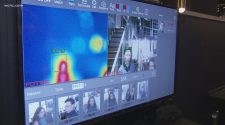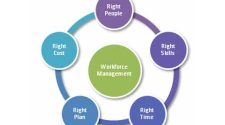The adoption of facial recognition software to identify customers will increase in the next few years, thanks to improvements in the technology though it has also been somewhat controversial, according to a panel talk at the recent Global Gaming Expo held at the Sands Expo Center in Las Vegas.
Panelists participating in the session, “Customer identification using facial recognition: the future is now,” agree the technology is more reliable and robust. Accuracy has been a main challenge with facial recognition, along with privacy concerns, since businesses and law enforcement began using the technology several years ago.
| Alec Massey introduces the panel. |
“We’re seeing (facial recognition) technologies actually performing now,” said panel moderator Alec Massey, director of PwC Connected Solutions practice for gaming, hospitality and leisure clients. “There’s a lot of good that comes with facial recognition.”
Facial recognition is a form of biometric identification that self-service kiosks are using to improve customer service, the others being fingerprint, retinal, palm print and thumb print scanning. While fingerprint scanning is considered the most common type of biometric identification, facial recognition is gaining in popularity.
Several restaurants have introduced facial recognition kiosks in recent years, including Burger Fi, based in South Florida; Caliburger, based in Pasadena, California; UFood Grill in Owings Mills, Maryland; Wao Bao, based in Chicago; and Malibu Poke, based in Dallas. Airports, hotel and casinos have also used facial recognition kiosks.
Companies that deploy kiosks — such as retailers and consumer brands — gave biometric identification a grade of 2.36 out of 4 as a “promising technology” in the 2019 Kiosk Marketplace Census Report.
Privacy concerns hamper adoption
Massey said privacy concerns continue to stem adoption of the technology, adding there is not yet any federal regulation governing how to use it. He noted some state and local governments have restricted its use by law enforcement. For example, San Francisco has banned the use of facial recognition by law enforcement and Somerville, Massachusetts and Oakland, California are considering similar laws.
Regulations will take time to evolve, agreed panelist Nasr Satta, vice president of the innovation group at NRT Technology Corp. “Regulators always take small steps, and we certainly understand,” he said.
Yet while the regulatory environment remains murky, many private businesses are adopting the technology, notably in the casino industry.
Technology improves
“It’s come so far in just a couple of years, it’s incredible,” said panelist David Logue, vice president of security and surveillance and night club compliance officer for The Cosmopolitan in Las Vegas. “I’m confident it will be a great tool for us.” He said the technology today is 30% to 40% better than it was two years ago.
The casino can identify a person as they enter the building, he said, which improves the safety of the environment. His company is already refusing to allow certain individuals onto its premises. Logue declined to name the product his company is using.
Satta agreed with Logue, adding that good facial recognition products have learning embedded in them. Satta said the technology can also help financial institutions comply with anti-money laundering requirements.
Satta viewed compliance as the “risk” side of facial recognition technology. He actually sees more benefits on what he called the “reward” side, such as comping a hotel guest with a benefit as soon as they sit down in the lobby.
The “rewards” benefits will evolve slowly, Satta said, as companies will need to require guests to opt in to be scanned.
Panelist Jessica Medeiros Garrison, president of MDM27, a business development consultancy, expanded on the technology improvements, noting some products have artificial intelligence and neural networks that can adjust for angles and lighting when capturing images of peoples’ faces.
“This artificial intelligence really didn’t take off until the last two years,” Garrison said. Not only are law enforcement agencies using it to solve crimes faster, they are finding it helps solve multiple cases simultaneously. The technology has assisted in the areas of financial fraud, violent crimes and human trafficking.
Is it a job killer?
As with other types of self-service technology, facial recognition raises the question of replacing human labor. To this point, Garrison said organizations using the technology are repurposing employees to higher-value tasks.
Logue said he doesn’t believe consumers will object to facial recognition cameras in buildings. He noted that consumers were initially apprehensive about metal detectors at club entrances, but have come to accept it as a benefit.
The Transportation Security Administration reported in September that it has assessed facial recognition’s ability to compare passenger photos taken at the checkpoint against identity documents following a test at the McCarran International Airport in Las Vegas. The TSA collected passengers’ photos and biographic information from identity documents and retained it temporarily for technical analysis.
Pictures by Networld Media Group.












